Volkswagen e-Golf: Used Car Buyer’s Guide
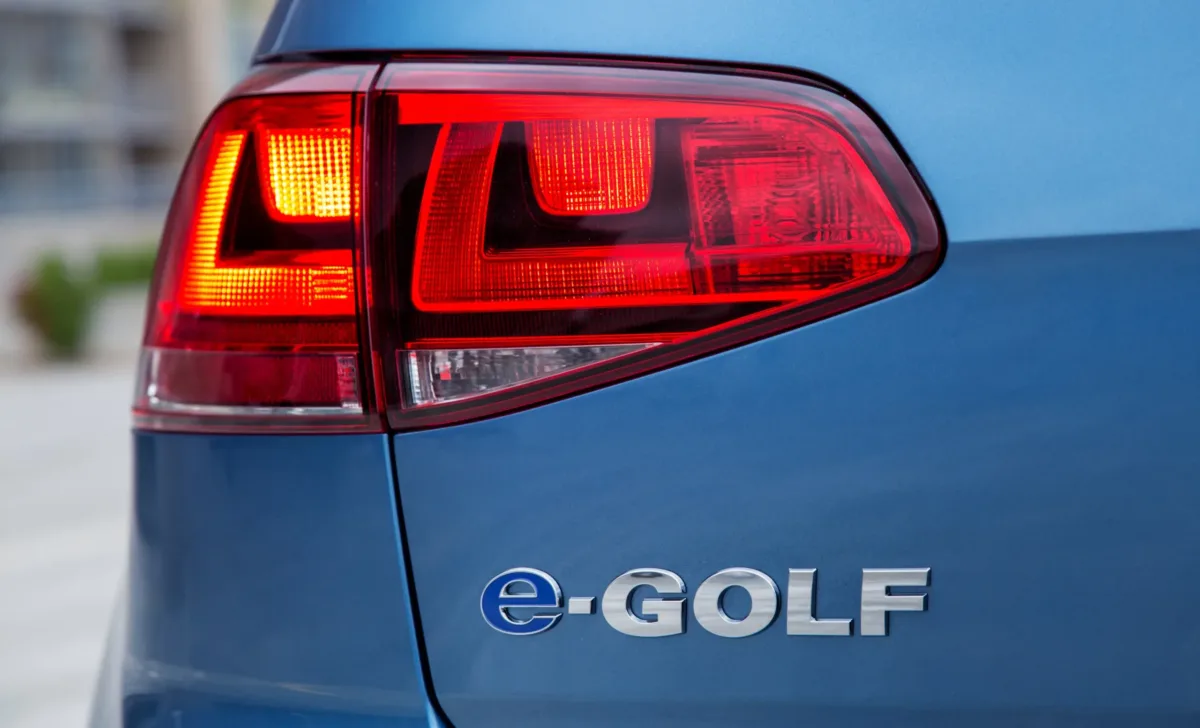
Contents
Quick Take
- Pros: fun for zipping around town, practical and versatile design, affordable
- Cons: limited range, air-cooled battery pack, desirable features limited to top trim
Volkswagen quietly entered the electric vehicle (EV) market in 2015 with the e-Golf. As the name implies, it’s a battery-powered version of the automaker’s popular compact hatchback, the Golf. That means it offers all of that model’s endearing qualities, including its fun-to-drive chassis, upscale interior, and practical design. Swapping the internal combustion engine for battery power makes the e-Golf even more engaging around town, with instant off-the-line response adding to its already agile feel. As a bonus, VW changed the powertrain without compromising any of the Golf’s excellent interior packaging and utility. The e-Golf, which ceased production in 2020, is also one of the least expensive EVs on the market.
On the downside, the e-Golf’s range is just 125 miles at best, limiting its usefulness as anything other than an urban runabout. Additionally, its battery pack relies on air cooling, making it more susceptible to degradation than liquid-cooled models, especially in more extreme climates. Finally, buyers must step up to the e-Golf’s top trim level to get some popular tech features, such as adaptive cruise control and blind-spot warning, which come standard on many newer EVs.
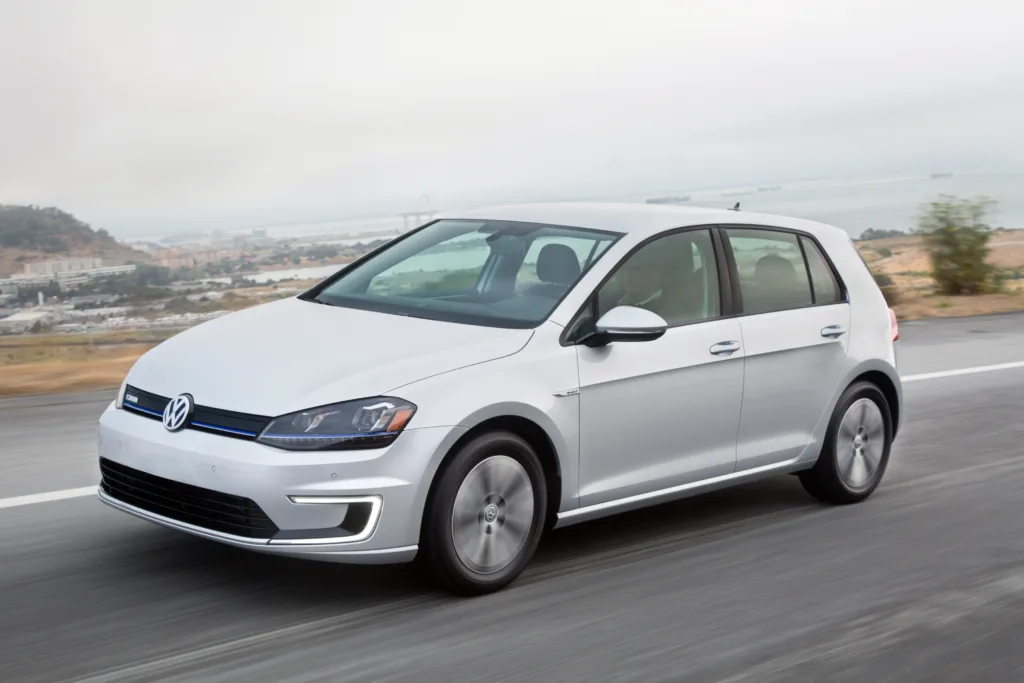
Performance, Range, and Charging
- A 2017 model year refresh added notable performance and range improvements
- Retains the engaging handling of the standard Golf with the added benefit of instant electric torque
- Charges in about 4-6 hours using a Level 2 home charger
When the e-Golf launched for the 2015 model year, it came with a relatively small 24.2-kWh lithium-ion battery pack. Paired with a 115-horsepower electric motor driving the front wheels, the setup hauls the car to 60 mph in a little over 9 seconds and delivers an EPA-rated 83 miles of range on a single charge.
If that’s not quite enough oomph or range, note that VW revised the e-Golf’s powertrain significantly starting with the 2017 model year, boosting the size of the battery pack to 35.8 kWh and the power of the electric motor to 134 ponies. That dropped its 0-60 mph time to around 8.5 seconds and upped its total range to 125 miles, an improvement of over 40 miles.
The e-Golf is a pleasure to drive. The low-mounted battery pack keeps the electric hatchback feeling planted through corners and stable on the highway. Meanwhile, electric propulsion keeps cabin noise levels to a minimum, making for a relaxed and comfortable ride. The drivetrain also offers four levels of regenerative braking via the shift lever, including a “B” position for one-pedal driving.
Charging times for the e-Golf depend somewhat on the model year and trim. Earlier models with the smaller battery pack (2015-16) can be fully recharged in about four hours using a 240-volt at-home charger. That increases to approximately six hours for later models with the larger pack (2017-19). Quicker recharging is available on the e-Golf via an optional 50-kW DC fast charger. It’s included on top-of-the-line SEL models and was made standard on all trims for 2019, the final model year. Also note that for one year only — 2016 — the base SE model came standard with a slower 3.6-kW onboard charger, which doubles its charging times.
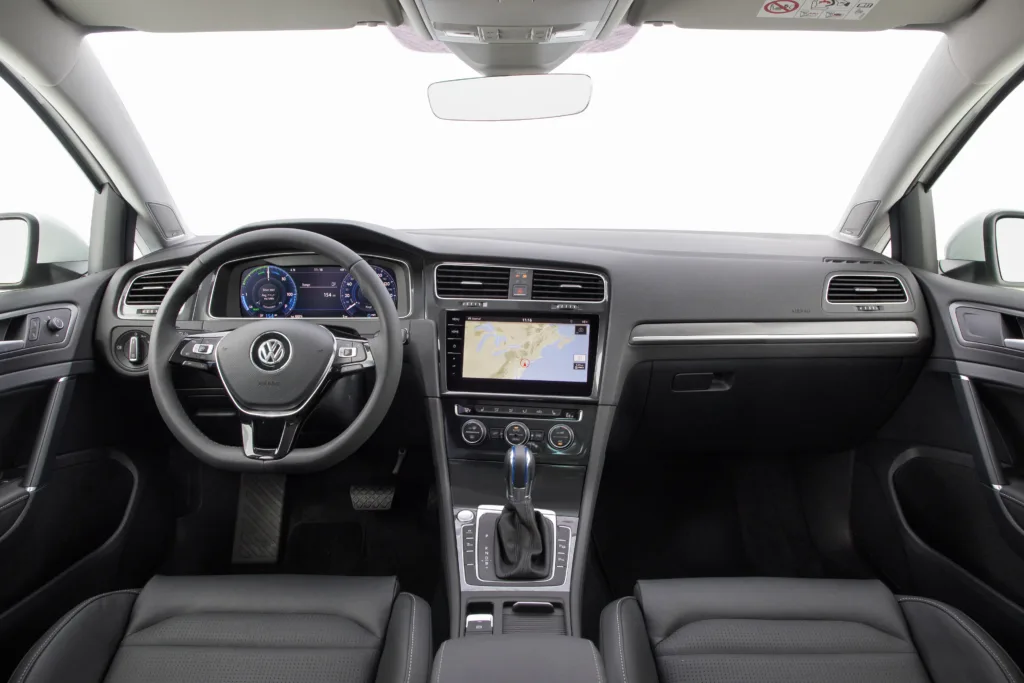
Interior, Features, and Trims
- Roomier and more upscale than most other economy models
- SE trim includes essential comfort and tech amenities
- SEL trim adds desirable tech and safety features
If you’re a fan of the standard Golf’s interior, you’ll also like the e-Golf’s. They’re nearly identical. They both offer a surprisingly roomy cabin with a level of quality that far surpasses most rival economy cars. The only things that distinguish the e-Golf are some unique blue trim accents and an electric power gauge, which takes the place of the tachometer.
Standard equipment on the base SE model is pretty generous. It includes keyless entry and ignition, cloth upholstery, heated front seats, dual-zone automatic climate control, a heated windshield, and a 6.5-inch infotainment touchscreen with Bluetooth connectivity and a USB port. Notably, VW improved the infotainment setup for 2017 and later SE models to an 8-inch touchscreen with Apple CarPlay and Android Auto integration.
Stepping up to the top-level SEL trim (called SEL Premium some years) introduces some considerable upgrades. It adds cruise control, parking sensors, faux leather upholstery, a larger infotainment touchscreen, and a digital instrument cluster (2017 and later models). It also offers the Drivers Assistance package, a bundle of advanced safety features, including adaptive cruise control, blind-spot monitoring, and automatic emergency braking. Additionally, the SEL comes standard with a heat pump, which is more efficient than a traditional heater, providing improved range in cold weather.
For the 2015 and 2017 model years, VW also offered a mid-range Limited Edition trim, which splits the difference between the SE and SEL.
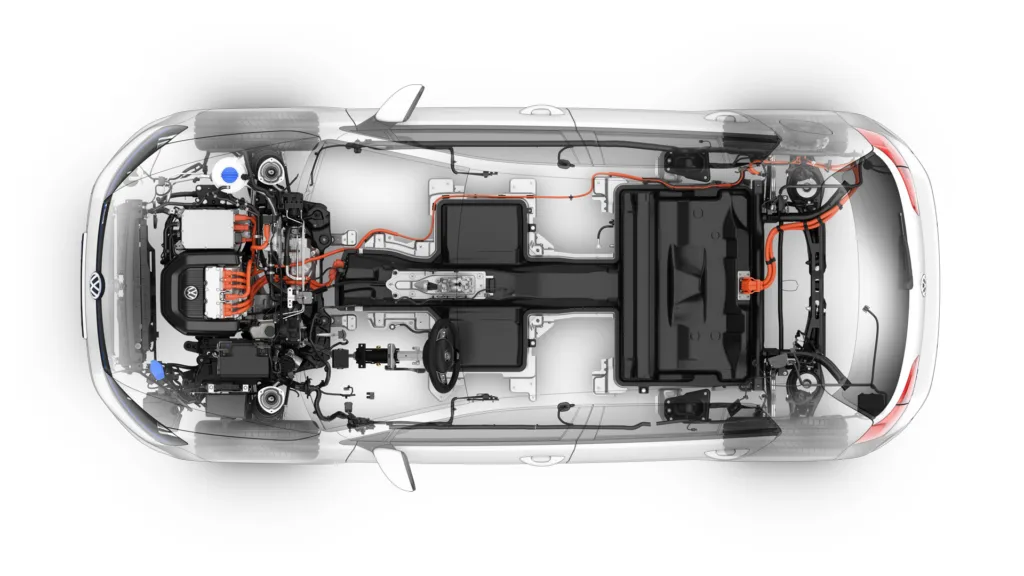
Problem Areas
The Volkswagen e-Golf, while generally well-received by the EV community, has had its share of issues that prospective buyers should be aware of.
Battery Degradation
Like all electric vehicles, the e-Golf’s battery pack will degrade over time. Notably, the e-Golf uses an air-cooled battery, which is less effective at managing temperature extremes than a liquid-cooled unit. This can lead to more significant degradation, especially in hot or cold climates. Prospective buyers should check the battery health of any used e-Golf, as a significantly degraded battery will not only reduce range but can also be costly to replace.
Charging Issues
Some owners have reported problems with charging their e-Golfs, including occasionally slow charging speeds and issues with connecting or disconnecting the charger. It’s essential to verify that the charging system is fully functional and that any recalls or software updates related to charging have been addressed prior to purchase.
Infotainment Glitches
Complaints about the responsiveness and functionality of the e-Golf’s infotainment system, particularly in its earlier model years, are not uncommon. While later models saw improvements with larger touchscreens and better software, it’s wise to test the infotainment system of any e-Golf extensively during a test drive to ensure it meets your expectations.
By paying close attention to these problem areas and having a trusted mechanic provide a thorough pre-purchase inspection, you can avoid many common pitfalls of buying a used e-Golf.
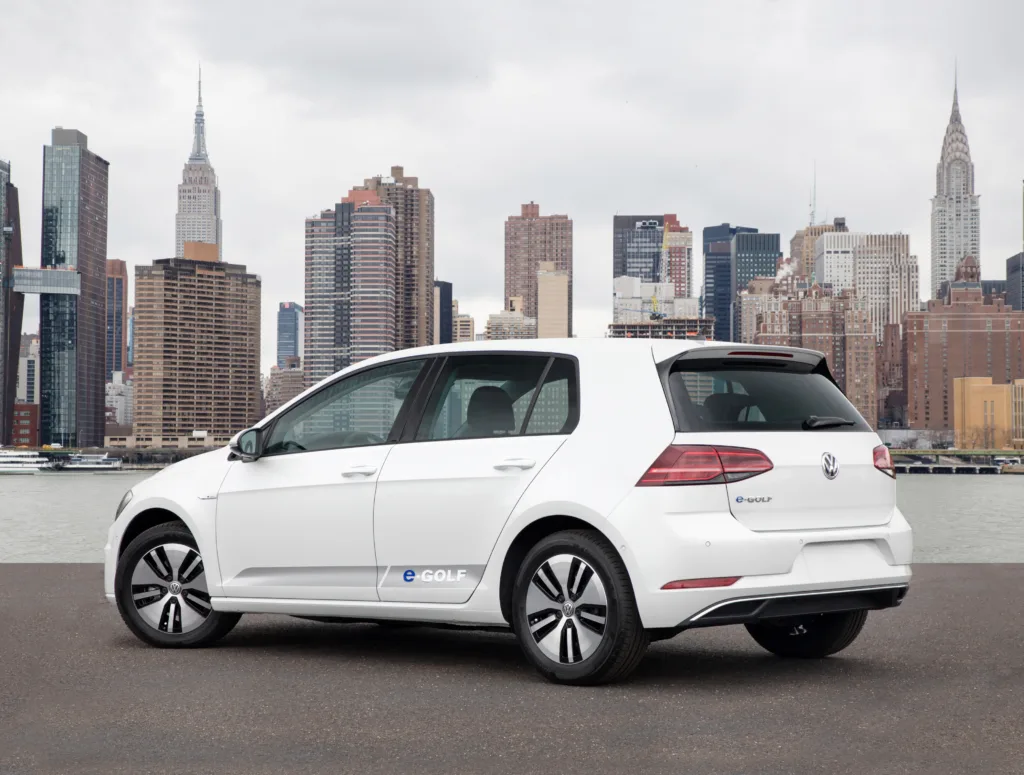
The Best Years: 2017-2019
We advise prospective e-Golf buyers to focus on the model’s later years, specifically from 2017 onwards. These stand out for several key reasons.
More Range
The 2017 model year marks a significant upgrade in the e-Golf’s battery capacity, jumping from the original 24.2-kWh pack to a more robust 35.8-kWh unit. This change delivered a much-appreciated boost in range from 83 to 125 miles, per EPA estimates.
Improved Performance
Starting in 2017, the e-Golf’s electric motor also received a 17% bump in power, from 115 to 134 horsepower. That makes these later models more responsive and engaging to drive.
Upgraded Tech
Technology features in the e-Golf also saw a significant upgrade starting in 2017. That’s when the base SE model gained a standard 8-inch touchscreen with Apple CarPlay and Android Auto integration. It’s also when the top-tier SEL Premium trim first offered some key driver aids in the optional Driver Assistance package, including adaptive cruise control and blind-spot warning.
Years to Avoid: 2015-2016
Used VW e-Golf buyers should tread carefully when it comes to the model’s first two model years. Here’s why.
Limited Range
The earliest iterations of the e-Golf use a small 24.2-kWh battery with an EPA-estimated range of just 83 miles. These days, when some EVs offer 300 miles or more on a single charge, this limited range can be a significant drawback, especially since some of that range has likely already eroded from battery degradation.
Slower Charging
For the 2016 model year, the base SE model came standard with a slow 3.6-kW onboard charger, which roughly doubles the time it takes to replenish its battery pack compared to other versions. Although a faster 7.2-kW charger was available, it was optional, and not all used 2016 models will be equipped with it.
Early Adoption Drawbacks
As with many first-generation electric vehicles, the initial model years of the e-Golf were part of Volkswagen’s learning curve in EV production. This means they may lack some of the refinements found in later years, whether in software, battery management, or other vehicle technology.
Technology and Features
The infotainment and driver assistance features in early e-Golfs lag behind those available in later years. Most notably, early models in the base SE trim lack the full smartphone integration and larger touchscreen that became standard in 2017, while early versions of the range-topping SEL lack key driver aids such as adaptive cruise control.
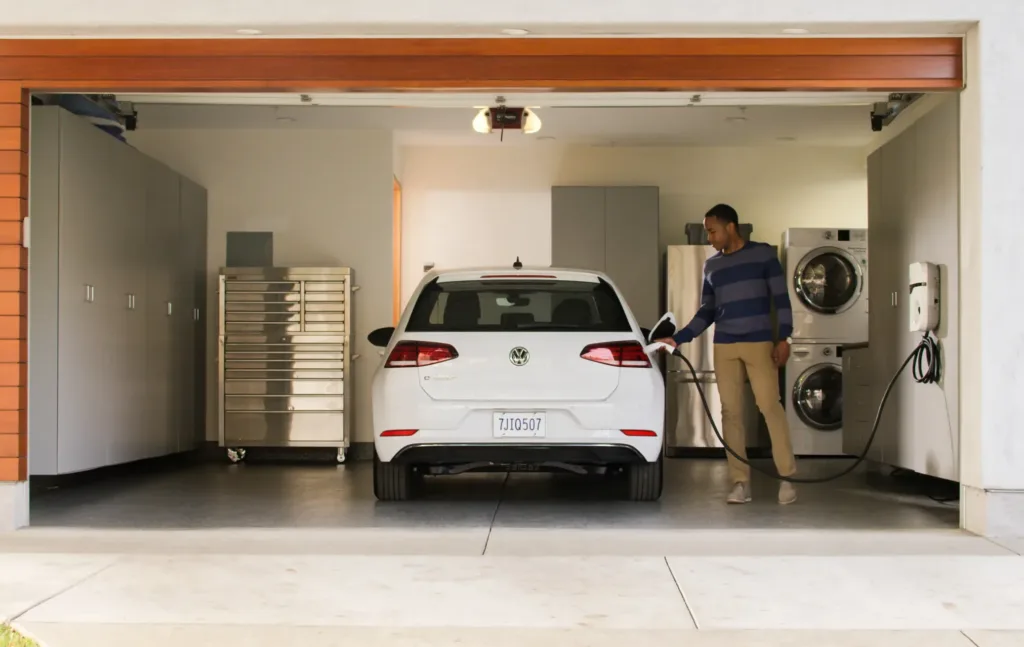
The Bottom Line
The Volkswagen e-Golf is an attractive proposition for those seeking a used electric car with a premium feel but without a premium price. Its engaging driving dynamics, practical and high-quality interior, and tidy dimensions make it well-suited for urban commuters. While its range may not compete with some newer EVs, the e-Golf makes up for it with its solid build quality and refined feel.
Buyers interested in a used e-Golf should prioritize the 2017 and newer models for their enhanced range, improved performance, and upgraded features. We also recommend seeking out examples outfitted in premium SEL trim for their added tech offerings.
But no matter which version you choose, we think a used e-Golf is a smart buy for the eco-conscious consumer who values comfort and performance in a compact and affordable package.
Photos courtesy of Volkswagen